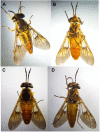The Human Filaria Loa loa: Update on Diagnostics and Immune Response
- PMID: 35936385
- PMCID: PMC9355020
- DOI: 10.2147/RRTM.S355104
The Human Filaria Loa loa: Update on Diagnostics and Immune Response
Abstract
Loa loa loiasis was considered an anecdotal disease 30 years ago. Its spread in Equatorial Africa and the side effects associated with mass drug administration programs against filariasis in co-endemic areas have drawn the attention of the international research community. Progress in research conducted to date has provided insight into the immunobiology of this parasite. An interesting finding reported in several studies is that 70% of individuals with loiasis do not carry microfilariae in their blood, and 30% are microfilaremic, suggesting the involvement of several immunological mechanisms, as shown by elevated specific IgG4 and IgE levels signifying a potential cross-linking mechanism between the two isotypes via L. loa antigen to prevent allergy. A mechanism of anergy in the appearance of microfilariae in the peripheral blood results in immunological unresponsiveness in individuals with microfilariae. There is an interaction between other pathogens (parasites, bacteria, viruses) in individuals co-infected with L. loa. The strong antigen cross-reactivity between L. loa and lymphatic filarial worms warrants a re-evaluation of the distribution of the latter in co-endemic regions. The mechanism of concomitant immunity observed in the elimination of microfilariae or infective larvae (third-stage larvae, L3) may be used for the conception of an immunoprophylactic strategy.
Keywords: Loa loa; cross-reactivity; diagnostics; immune anergy; immune evasion.
© 2022 Dieki et al.
Conflict of interest statement
The authors report no conflicts of interest for this work.
Figures









Similar articles
-
Further evidence of the cross-reactivity of the Binax NOW® Filariasis ICT cards to non-Wuchereria bancrofti filariae: experimental studies with Loa loa and Onchocerca ochengi.Parasit Vectors. 2016 May 5;9:267. doi: 10.1186/s13071-016-1556-8. Parasit Vectors. 2016. PMID: 27151313 Free PMC article.
-
High levels of parasite-specific IgG4 in the absence of microfilaremia in Loa loa infection.Trop Med Parasitol. 1994 Sep;45(3):246-8. Trop Med Parasitol. 1994. PMID: 7899797
-
IgG subclass recognition of Loa loa antigens and their correlation with clinical status in individuals from Gabon.Parasite Immunol. 1998 Aug;20(8):387-93. doi: 10.1046/j.1365-3024.1998.00172.x. Parasite Immunol. 1998. PMID: 9767604
-
Loa loa vectors Chrysops spp.: perspectives on research, distribution, bionomics, and implications for elimination of lymphatic filariasis and onchocerciasis.Parasit Vectors. 2017 Apr 5;10(1):172. doi: 10.1186/s13071-017-2103-y. Parasit Vectors. 2017. PMID: 28381279 Free PMC article. Review.
-
Loa loa infection detection using biomarkers: current perspectives.Res Rep Trop Med. 2018 Apr 3;9:43-48. doi: 10.2147/RRTM.S132380. eCollection 2018. Res Rep Trop Med. 2018. PMID: 30050354 Free PMC article. Review.
Cited by
-
Application of loop mediated isothermal amplification (LAMP) assays for the detection of Onchocerca volvulus, Loa loa and Mansonella perstans in humans and vectors.Front Trop Dis. 2023 Jan 9;3:1016176. doi: 10.3389/fitd.2022.1016176. Front Trop Dis. 2023. PMID: 36684508 Free PMC article.
-
Bactericidal antibiotic treatment induces damaging inflammation via TLR9 sensing of bacterial DNA.Nat Commun. 2024 Nov 28;15(1):10359. doi: 10.1038/s41467-024-54497-3. Nat Commun. 2024. PMID: 39609397 Free PMC article.
-
Microfilariae Prevalence and its Association with Anemia Among First-time Blood Donors in Lambaréné, Gabon.Balkan Med J. 2024 Mar 1;41(2):139-143. doi: 10.4274/balkanmedj.galenos.2023.2023-9-86. Epub 2024 Jan 23. Balkan Med J. 2024. PMID: 38259115 Free PMC article.
-
Clinical and epidemiological features of imported loiasis in Beijing: a report from patients returned from Africa.BMC Infect Dis. 2024 Jul 20;24(1):714. doi: 10.1186/s12879-024-09620-6. BMC Infect Dis. 2024. PMID: 39033158 Free PMC article.
-
Beyond Tradition: Exploring Cutting-Edge Approaches for Accurate Diagnosis of Human Filariasis.Pathogens. 2024 May 24;13(6):447. doi: 10.3390/pathogens13060447. Pathogens. 2024. PMID: 38921745 Free PMC article. Review.
References
-
- UNDP/World Bank/WHO Special Programme for Research and Training in Tropical Diseases. Guidelines for Rapid Assessment of Loa Loa. World Health Organization; 2002.
-
- Peters W. Manson’s Tropical Diseases. Trans R Soc Trop Med Hyg. 1996;90(2):207–208.
Publication types
LinkOut - more resources
Full Text Sources

